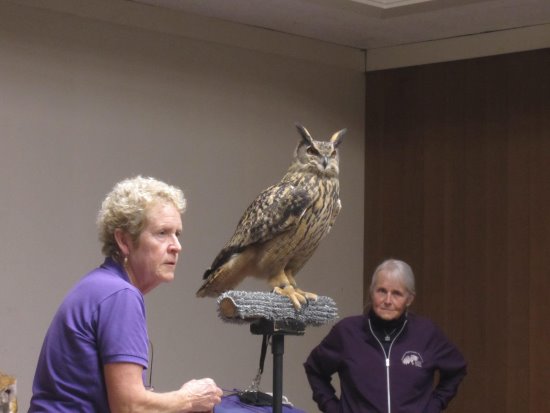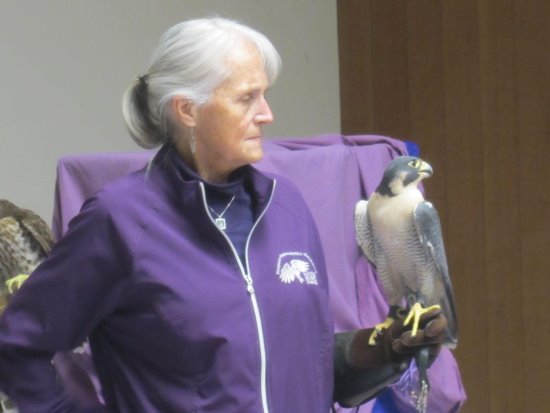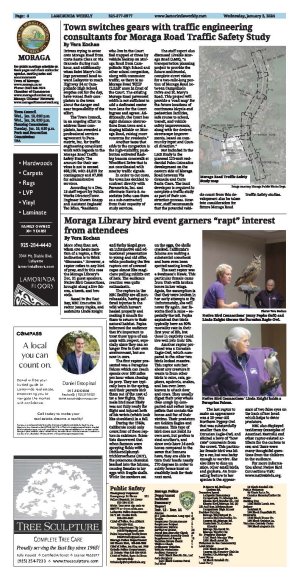| | Published January 3rd, 2024
| Moraga Library bird event garners "rapt" interest from attendees
| | | By Vera Kochan |  | | Native Bird Connections' Jenny Papka (left) and Linda Knight discuss the Eurasian Eagle-Owl. Photo Vera Kochan |
More often than not, when one hears mention of a raptor, a first inclination is to think "dinosaurs." However, a raptor refers to any bird of prey, and in this case the Moraga Library's Dec. 21 guest speakers, Native Bird Connections, brought along a live falcon, a hawk, and two owls.
 Based in the East Bay, NBC Executive Director Jenny Papka, and assistants Linda Knight and Kathy Siegel gave an informative and educational presentation to young and old alike, while producing the live raptors out of covered cages almost like magicians pulling rabbits out of hats. The audience reaction was quite enthusiastic.
Based in the East Bay, NBC Executive Director Jenny Papka, and assistants Linda Knight and Kathy Siegel gave an informative and educational presentation to young and old alike, while producing the live raptors out of covered cages almost like magicians pulling rabbits out of hats. The audience reaction was quite enthusiastic.
 The raptors in the NBC facility are all non-releasable, having suffered injuries in the wild which haven't healed properly and making it unsafe for them to return to their natural habitat. Papka informed the audience that it's important to treat these types of animals with respect, especially since they can no longer live in their own environment, but are now in ours.
The raptors in the NBC facility are all non-releasable, having suffered injuries in the wild which haven't healed properly and making it unsafe for them to return to their natural habitat. Papka informed the audience that it's important to treat these types of animals with respect, especially since they can no longer live in their own environment, but are now in ours.
 The first raptor presented was a Peregrine Falcon which can reach speeds over 200 miles per hour when chasing its prey. They are typically born in the spring, and their parents kick them out of the nest after a few flights. This male bird most likely was not fully ready for flight and injured both of his wrists (which look like shoulders) in a fall.
The first raptor presented was a Peregrine Falcon which can reach speeds over 200 miles per hour when chasing its prey. They are typically born in the spring, and their parents kick them out of the nest after a few flights. This male bird most likely was not fully ready for flight and injured both of his wrists (which look like shoulders) in a fall.
 During the 1960s, California could only count four of these raptors in existence. Scientists discovered that when farmers were spraying fields with
During the 1960s, California could only count four of these raptors in existence. Scientists discovered that when farmers were spraying fields with
 Dichlorodiphenyltrichloroethane (DDT), the poisonous chemical leached into the falcons, causing females to lay eggs with fragile shells. While the mothers sat on the eggs, the shells cracked. California's falcons are making a substantial comeback and have even been spotted nesting locally.
Dichlorodiphenyltrichloroethane (DDT), the poisonous chemical leached into the falcons, causing females to lay eggs with fragile shells. While the mothers sat on the eggs, the shells cracked. California's falcons are making a substantial comeback and have even been spotted nesting locally.
 The next raptor was a Swainson's Hawk. This particular female came from Utah with broken bones in her wings. Again, the assumption is that they were broken in her early attempts to fly. Unfortunately, she will never fly again. Her favorite food is mice - especially the tail. Papka explained that birds typically have an 80% mortality rate in their first year of life, but those in captivity could live well into their 20s.
The next raptor was a Swainson's Hawk. This particular female came from Utah with broken bones in her wings. Again, the assumption is that they were broken in her early attempts to fly. Unfortunately, she will never fly again. Her favorite food is mice - especially the tail. Papka explained that birds typically have an 80% mortality rate in their first year of life, but those in captivity could live well into their 20s.
 Another raptor produced was a Eurasian Eagle-Owl, which compared to the other two birds looked massive. This raptor eats just about any creature it wants to from other birds to mice, rats, gophers, squirrels, snakes, and has even been known to attack deer and cows. They usually digest their prey whole then cough up compacted and rather large pellets that contain the bones and fur of their victims. Their predators are Golden Eagles and humans. This type of bird does not build its own nest, but prefers to steal another's, and since owls have 14 neck bones compared to the seven that humans have, they are able to turn their heads nearly 270 degrees in order to subtly house hunt or stealthily look for their next meal.
Another raptor produced was a Eurasian Eagle-Owl, which compared to the other two birds looked massive. This raptor eats just about any creature it wants to from other birds to mice, rats, gophers, squirrels, snakes, and has even been known to attack deer and cows. They usually digest their prey whole then cough up compacted and rather large pellets that contain the bones and fur of their victims. Their predators are Golden Eagles and humans. This type of bird does not build its own nest, but prefers to steal another's, and since owls have 14 neck bones compared to the seven that humans have, they are able to turn their heads nearly 270 degrees in order to subtly house hunt or stealthily look for their next meal.
 The last raptor to make an appearance was a 20-year-old Northern Pygmy-Owl that was substantially smaller than the Eurasian Eagle-Owl, and elicited a bevy of "how cute" comments from the crowd. This particular female bird was hit by a car, but was lucky enough to survive. She also likes to dine on mice, other small birds, and gophers. An interesting feature to her species is the appearance of two false eyes on the back of her head which helps to deter predators.
The last raptor to make an appearance was a 20-year-old Northern Pygmy-Owl that was substantially smaller than the Eurasian Eagle-Owl, and elicited a bevy of "how cute" comments from the crowd. This particular female bird was hit by a car, but was lucky enough to survive. She also likes to dine on mice, other small birds, and gophers. An interesting feature to her species is the appearance of two false eyes on the back of her head which helps to deter predators.
 NBC also displayed taxidermy (examples of American Kestrels) and other raptor-related artifacts for the curious to see; and there were many thoughtful questions from the children in the audience.
NBC also displayed taxidermy (examples of American Kestrels) and other raptor-related artifacts for the curious to see; and there were many thoughtful questions from the children in the audience.
 For more information about Native Bird Connections visit: www.nativebirds.org.
For more information about Native Bird Connections visit: www.nativebirds.org. |
 | | Native Bird Connections' Linda Knight holds a Peregrine Falcon. Photo Vera Kochan | | | | | | | | | | | |




